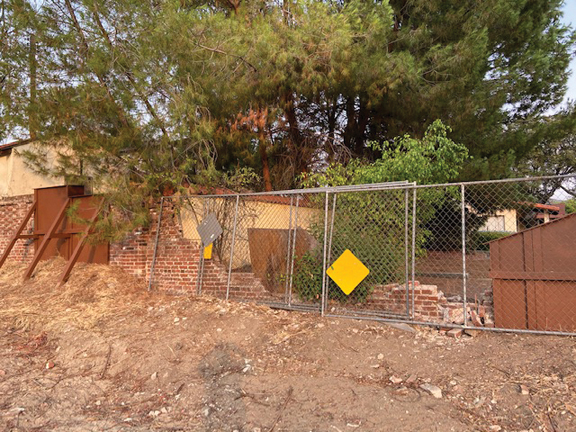
The retaining wall on the west side of the Rockhaven property has crumbled and is being shored up with temporary fencing.
By Charly SHELTON
Rockhaven. No property in the Crescenta Valley sparks more discussion or controversy over its proper use. Last week, we offered part one of this two-part series on Rockhaven Sanitarium. We shared the history of the property and its current state, specifically that it has fallen into deep disrepair due to an apparent lack of communication and slapdash maintenance efforts. As reported in last week’s story, plywood can be seen closing off a breach in the exterior fence, the roof is coming apart while wind-tattered tarps hang down. Joanna Linkchorst, president of the preservation group Friends of Rockhaven, related her interaction with City of Glendale officials who told her one area with plywood closing off the doorway was “not safe” to enter.
But Rockhaven has the distinction of being recognized on the National Register of Historic Places at the state level as a historic district. Under certain circumstances, this provides owners with protections and benefits while also providing certain restrictions.
The National Register of Historic Places was created with the National Historic Preservation Act of 1966 and falls within the purview of the National Park Service. It is the national official list of cultural resources worthy of preservation. This includes sites of national, state or local significance in the areas of history, architecture, archaeology, engineering, and/or culture. Being on the National Register at the state level of importance as a historic district covers most of the Rockhaven Sanitarium buildings as well as the gardens in a blanket designation.
According to California State Statute 37361, “[City government] may acquire property for the preservation or development of a historical landmark. The legislative body may also acquire property for development for recreational purposes and for development of facilities in connection therewith.”
This is what the City of Glendale did in 2008 when it purchased the Rockhaven site. The City actually saved the property from being demolished by its then-owners, with the intention of finding a development partner to make it a public community space, said Eliza Papazian, public information officer for the City of Glendale.
But after 10 years of ownership and numer-ous failed attempts with developers to make suitable use of the buildings while preserving their character, “City Council decided to pursue alternative options,” Papazian said. Most recently, a development company wanted to use the Rockhaven property as a boutique hotel but this proposal was also left to expire due to the financial infeasibility of the work that needed to be done.
When it purchased the property and stated that it would preserve the resource, the City made a public commitment.
“The Glendale City Council has an obligation to protect the City’s resources and remains committed to doing so,” Papazian said.
So while the bids go out time and again for developers to work with the site Rockhaven rots. The roofs fall apart, water seeps in and entire rooms become “not safe” to enter. It might be easier for the City to find a developer to use the land and recoup some financial losses if the historic buildings weren’t playing a part in the decision-making process. But due to the protection in place from local laws, outright demolition of the buildings is not allowed.
“Demolition by Neglect means the process in which the owner of a building or structure allows its ongoing deterioration over a period of time as a result of lack of maintenance, failure to secure it from pests or vandals, and/or failure to take reasonable measures to prevent ingress of water or wind through the roof, walls, or apertures, leading to deterioration and/or structural failure constituting a threat to public health and safety,” according to the City of Glendale’s Municipal Code 15.20.020.
The Glendale Municipal Code specifically references the conditions found at Rockhaven, namely the failure to secure the site and taking measures to prevent ingress of water, leading to a threat to safety. The Code also admonishes these conditions stating in 15.20.120 Duty to Maintain Historic Resources: “Every owner of a designated historic resource shall maintain [the property in a manner that] does not constitute ‘demolition by neglect’ and prevents deterioration, dilapidation and decay of any portion of such resource.”
When asked pointedly about these conditions, which resemble “demolition by neglect,” Papazian said, “The City is not deliberately letting the property deteriorate. The City treasures the historical significance of Rockhaven and will continue to uphold it.”
Papazian told CV Weekly that access to the site will be secured and the buildings will be re-tarped as necessary before the rainy season. And as of now, “There are no agreements to dispose of the land at this time,” Papazian said.
To read the first half of this story,
visit CVWeekly.com.
